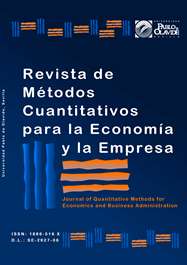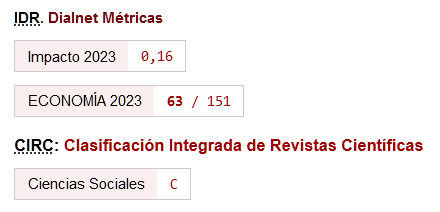Valuation of competitive strategies, collaborative agreements and penalties with Multinomial Real Options and Game Theory
DOI:
https://doi.org/10.46661/revmetodoscuanteconempresa.6092Keywords:
strategies valuation, multinomial real options, game theory, pre-emption, join venture, penalties valuationAbstract
In competitive environments, the design and election of strategies demand considered three potential sources of uncertainty: risks derived from self-actions, risks emerged from states of nature and risks derived from competitors´ decisions. The Real Options Theory analyses the first two risks, but doesn´t incorporate the uncertainty derived from competitors´ actions. For that, the Games Theory must be added to the model. Its develops a numerical model of Games Theory and Multinomial Real Options for value sequential preemption strategies and join venture. In addition, for the agreement a penalty calculator model is developed, an analytic tool for calculating monetary compensations facing contractual defaults. The strategies pure and mixed are selected with Nash equilibrium and valued with multinomial real options model. The theoretical framework exposes the binomial and multinomial model for valuing non correlation technological and markets risk. Also, Game Theory´ basic elements and resolutions forms are developed. Next, using the cases methodology, the model is applied for valuing preemption and join venture strategies cases. The obtained results are showed in extensive and matrix form. Finally, for inducing cooperative behaviors and agreement´s observance, the pecuniary fine valuation is exposed.
Downloads
References
Aguado, J.C. (2007). Teoría de la decisión y de los juegos. Madrid: Delta Publicaciones.
Armada, M., Kryzanowski, L., & Pereira, P. (2009). Optimal investment decisions for two positioned firms competing in a duopoly market with hidden competitors. European Financial Management, 17(2), 305-330. https://doi.org/10.1111/j.1468-036X.2009.00514.x
Arnold, T., & Crack, T. (2003). Option Pricing in the Real World: A Generalized Binomial Model with Applications to Real Options. Social Science Research Network SSRN. https://doi.org/10.2139/ssrn.240554
Axelrod, R. (1981). The Emergence of Cooperation among Egoists. The American Political Science Review, 75(2), 306-318. https://doi.org/10.2307/1961366
Axelrod, R. (1986). La Evolución de la Cooperación. Madrid, España: Alianza Editoria S.A.
Black, F., & Scholes, M. (1972). The Valuation of Options Contracts and a Test of Market Efficiency. Journal of Finance, 27(2), 399-417. https://doi.org/10.2307/2978484
Boyer, M., Laserrere, P., & Moreaux, M. (2012). A dynamic duopoy investement game without commitment under uncertainty market expansion. Interntational Journal of Industrial Organization, 30(6), 663-681. https://doi.org/10.1016/j.ijindorg.2012.07.005
Boyle, P. (1988). A lattice framework for option pricing with two state variables. Journal of Finance and Quantitative Analysis, 23(1), 1-12. https://doi.org/10.2307/2331019
Brandao, L., & Dyer, J. (2009). Projetos de Opcoes Reis com Incertezas Correlacionadas. Revista de Administracao e Contabilidade da Unisinos, 6(1), 19-26. https://doi.org/10.4013/base.2009.61.02
Brandao, L., Dyer, J., & Hahnn, W. (2012). Volatility estimation for stochastic project value models. European Journal of Operational Research, 220(3), 642-648. https://doi.org/10.1016/j.ejor.2012.01.059
Brennan, M., & Trigeorgis, L. (2000). Real options: Development and new contributions In: Project Flexibility, Agency, and Competition. New Developments in the Theory and Application of Real Options. EE.UU: Oxford University Press.
Broadie, M,. & Kaya, O. (2007). A Binomial Lattice Method for Pricing Corporate Debt and Modelling Chapter 11 Procedings. Journal of Finance and Quantitative Analysis, 42(2), 279-312. https://doi.org/10.1017/S0022109000003288
Brockman, P., & Turtle, H. (2003). A Barrier Option Framework for Corporate Security Valuation. Journal of Financial Economics, 67(3), 511-529. https://doi.org/10.1016/S0304-405X(02)00260-X
Brous, P. (2011). Valuing an Early-Stage Biotechnology Investment as a Rainbow Option. Journal of Applied Corporate Finance, 23(2), 94-103. https://doi.org/10.1111/j.1745-6622.2011.00331.x
Castro, E. (2010). El estudio de casos como metodología de investigación y su importancia en la dirección y administración de empresas. Revista Nacional de Administración, 1(2), 31-54. https://doi.org/10.22458/rna.v1i2.332
Chance, D. (2008). A Synthesis of Binomial Option Pricing Models for Lognormally Distributed Assets. Journal of Applied Finance, 18(1), 38-56. https://doi.org/10.2139/ssrn.969834
Chevalier-Roigant, B., & Trigeorgis, L. (2011). Competitive Strategy: Options and Games. Cambridge, Massachusetts, London, England: MIT Press.
Chevalier-Roignant, B., Flath, C., & Trigeorgis, L. (2011). Strategic investment under uncertainty: A synthesis. European Journal of Operational Research, 215(3), 639-650. https://doi.org/10.1016/j.ejor.2011.05.038
Copeland, T., & Antikarov, V. (2003). Real Options: a practitioner´s guide. New York: Cengage Learning.
Cox, J., Ross, S., & Rubinstein, M. (1979). Option Pricing: A Simplified Approach. Journal of Financial Economics, 7(3), 229-263. https://doi.org/10.1016/0304-405X(79)90015-1
Culik, M. (2016). Real options valuation with changing volatility. Pespectives in Science, 7, 10-18. https://doi.org/10.1016/j.pisc.2015.11.004
Derman, E., Kani, I., & Chriss, N. (1996). Implied Trinomial Trees of the Volatility Smile. (Goldman-Sachs, Ed.) Quantitative Strategies Research Notes, 14, 1-27.
Dixit, A., & Pindyck, R. (1994). Investment under Uncertainty (1 ed.). New Jersey: Pricenton University Press.
Dixit, A., & Nalebuff, B. (1991). Thinking Strategically: The competitive edge in business, politics and everyday life. New York, EE.UU: Norton Press.
Fudenberg, D., & Tirole, J. (1985). Preemption and rent equalization in the adoption of new technology. Review of Economics Studies, 52(3), 383-401. https://doi.org/10.2307/2297660
Fudenberg, D., & Tirole, J. (1986). A theory of exit in doupoly. Econometrica, 54(4), 943-960. https://doi.org/10.2307/1912845
Gamba, A., & Trigeorgis, L. (2007). An Improved Binomial Lattice Method for Multi-Dimensional Options. Applied Mathematical Finance, 14(5), 453-475. https://doi.org/10.1080/13504860701532237
Ghemawat, P., & Nalebuff, B. (1985). Exit. Journals of Economics, 16(2), 184-194. https://doi.org/10.2307/2555409
Graham, J. (2011). Strategic real options under asymmetric information. Journal of Economics and Dynamic Control, 35(6), 922-934. https://doi.org/10.1016/j.jedc.2011.01.001
Grenadier, S. (1996). The strategic exercise of options: Development cascades and overbuilding in real state markets. Journal of Finance, 51(5), 1653-1679. https://doi.org/10.1111/j.1540-6261.1996.tb05221.x
Grenadier, S. (2002). Option exercise games: an application to the equilibrium investement strategies of firms. Review of Financial Studies, 15(3), 691-721. www.jstor.org/stable/2696718
Grenadier, S. (2005). Options exercise games: The intersection of real options and game theory. Journal of Applied Corporate Finance, 13(2), 99-107. https://doi.org/10.1111/j.1540-6261.1996.tb05221.x
Guintis, H. (2009). Game Theory Evolving (2 ed.). United Kingdom: Princeton University Press.
Haahtela, T. (2010). Recombining trinomial tree for real option valuation with changing volatility. Social Science Research Network, 1-25. https://doi.org/10.2139/ssrn.1932411
Haahtela, T. (2011). Estimating Changing Volatility in Cash Flow Simulation Based Real Options Valuation with Regression Sum of Squared Error Method. Social Science Research Network. https://doi.org/10.2139/ssrn.1
Herath, H., & Kumar, P. (2006). Multinomial Approximating Models for Options. 1-37. https://citeseerx.ist.psu.edu/viewdoc/download?doi=10.1.1.529.6466&rep=rep1&type=pdf
Hsu, Y., & Lambrecht, B. (2007). Preemptive patenting under uncertainty and asymmetric information. Annals of Operations Research, 151(1), 5-28. https://doi.org/10.1007/s10479-006-0125-5
Jabbour, G., Kramin, M., & Young, S. (Noviembre de 2001). Two-state Option Pricing: Binomial Models Revisited. Journal of Futures Markets, 21(11), 987-1001. https://doi.org/10.1002/fut.2101
Jarrow, R., & Rudd, A. (1982). Approximate option valuation for arbitrary stochastic processes. Journal of Financial Economics, 10(3), 347-369. https://doi.org/10.1016/0304-405X(82)90007-1
Kamrad, B., & Ritchken, P. (1991). Multinomial Approximating Models for Options with k State Variables. Management Science, 37(12), 1640-1653. https://doi.org/10.1287/mnsc.37.12.1640
Korn, R., & Muller, S. (2009). The decoupling approach to binomial pricing of multi-asset options. The Journal of Computational Finance, 12(3), 1-30. https://doi.org/10.21314/jcf.2009.207
Kreps, D., Milgron, P., Roberts, J., & Wilson, R. (1982). Rational Cooperation in Finitely Repeated Prisioner´s Dilemmas. Journal of Economics Theory, 27(2), 245-252. https://doi.org/10.1016/0022-0531(82)90029-1
Kulatilaka, N., & Perotti, E. (1998). Strategic growth options. Management Science, 44(8), 1021-1031. https://doi.org/10.1287/mnsc.44.8.1021
Lambrecht, B. (2001). The impact of debt financing on entry and exit in duopoly. Review of Financial Studies, 14(3), 765-804. www.jstor.org/stable/2696773
Lambrecht, B., & Perraudin, W. (2003). Real options and preemption under incomplete information. Journal of Economics Dynamics and Control, 27(4), 619-643. https://doi.org/10.1016/S0165-1889(01)00064-1
Lari-Lavassani, A., Simchi, M., & Ware, A. (2001). A discrete valuation of swing options. Canadian applied mathematics quarterly, 9(1), 35-73. https://doi.org/10.1.1.571.8300
Massé, P. (1963). La elección de las inversiones: criterios y métodos. Sagitario Ediciones.
Medina, R., & Rodriguez, Y. (2010). Una revisión de los modelos de volatilidad estocástica. Comunicaciones en Estadística, 3(1), 79-97. https://doi.org/10.15332/s2027-3355.2010.0001.05
Merton, R. (1973). The Theory of Rational Options Princing. Bell Journal of Economics and Management Science, 141-183.
Merton, R. (1974). On the pricing of crporate debt: the risk structure of interest rates. Journal of Finance, 29(2), 449-470. https://doi.org/10.1111/j.1540-6261.1974.tb03058.x
Milanesi, G. (2011). Flexibilidad estratégica, teoría de opciones reales y convergencia con el VAN empleando coeficientes equivalentes ciertos y probabilidades del "mundo real". SaberEs(3), 47-60. repositoriodigital.uns.edu.ar/handle/123456789/4255
Milanesi, G. (2013). Asimetría y Curtosis en el Modelo Binomial para valora Opciones Reales: caso de aplicación para empresas de base tecnológica. Estudios Gerenciales Journal of Management and Economics for Iberoamerica, 29(128), 368-378. https://doi.org/10.1016/j.estger.2013.09.011
Milanesi, G. (2019). Predicciones de fracasos financieros con opciones reales barrera: un estudio para el mercado argentino. Estudios de Administración, 26(2), 53-81. https://doi.org/10.5354/0719-0816.2019.56951
Milanesi, G. (2021). Modelo de valoración con opciones reales, rejillas trinomial, volatilidad cambiante, sesgo y función isoelástica de utilidad. Revista de Métodos Cuantitativos para la Economía y la Empresa, 32, 257-273. https://doi.org/10.46661/revmetodoscuanteconempresa.4602
Milanesi, G. (2022). Opciones reales secuenciales cuadrinomiales y volatilidad cambiante: Incertidumbres tecnológicas y de mercado en desarrollos de inversiones biotecnológicas. Revista Méxicana de Economía y Finanzas (REMEF), 17(1), 24-49. https://doi.org/10.21919/remef.v17i1.500
Milanesi, G., Pesce, G., & El Alabi, E. (2013). Technology-Based Start up Valuation using Real Opciones with Edgeworth Expansion. Journal of Financial and Accounting, 1(2), 54-61. https://doi.org/10.12691/jfa-1-2-3
Milanesi, G., Pesce, G., & El Alabi, E. (2016). Firm valuation and default probability through exotic (barrier) options. European Accounting and Management Review, 2(2), 56-76. papers.ssrn.com/sol3/papers.cfm?abstract_id=2888799 . https://doi.org/10.26595/eamr.2014.2.2.4
Milanesi, G., & Thomé, F. (2015). Un modelo consolidado de opciones reales, teoría de juegos y análisis de costos de transacción para el diseño de acuerdos contractuales. Revista de Economía Política de Buenos Aires, 14, 59-81. ojs.econ.uba.ar/index.php/REPBA/article/view/824
Milanesi, G., & Tohmé, F. (2014). Árboles Binomiales Implícitos, Momentos Estocásticos de Orden Superior y Valuación de Opciones. Revista de Economía Política (REPBA), 12(7), 45-72. ojs.econ.uba.ar/index.php/REPBA/article/view/559
Murto, P. (2004). Exit in duopoly under uncertainty. Journal of Economics, 35(1), 111-127. https://doi.org/10.2307/1593732
Nash, J. (1953). Two-Person Cooperative Games. Econometrica, 21(1), 128-140. https://doi.org/10.2307/1906951
Pareja, J., Prada, M., & Moreno, M. (2019). Volatilidad en Opciones Reales: Revisión literaria y un caso de aplicación al sector petrolero colombiano. Revista de Métodos Cuantitativos para la Economía y la Empresa, 27, 136-155. www.upo.es/revistas/index.php/RevMetCuant/article/view/2820
Pawlina, G., & Kort, P. (2006). Real options in an asymmetric duopoly: Who benefits from your competitive disadvantage? Journal of Economics and Management Strategy, 15(1), 1-35. https://doi.org/10.1111/j.1530-9134.2006.00090.x
Paxson, D., & Melmane, A. (2009). Multi factor competitive internet strategy evaluation: Search expansion, portal synergies. Journal of Modeling Management, 4(3), 249-273. https://doi.org/10.1108/17465660911006477
Paxson, D., & Pinto, H. (2003). Rivalry under price and quantity uncertainty. Review of Financial Economics, 14(3-4), 209-224. https://doi.org/10.1016/j.rfe.2005.04.002
Rendleman, R., & Bartter, B. (1979). Two State Option Pricing. The Journal of Finance, 34(5), 1093-1110. https://doi.org/10.1111/j.1540-6261.1979.tb00058.x
Rubinstein, M. (1983). Displaced Diffusion Option Pricing. Journal of Finance, 38(1), 213-217. https://doi.org/10.1111/j.1540-6261.1983.tb03636.x
Rubinstein, M. (1994). Implied Binomial Trees. Journal of Finance, 49(3), 771-818. https://doi.org/10.1111/j.1540-6261.1994.tb00079.x
Rubinstein, M. (1998). Edgeworth Binomial Trees. Journal of Derivatives, 5(3), 20-27. https://doi.org/10.3905/jod.1998.407994
Rubinstein, M. (2000). On the Relation Between Binomial and Trinomial Option Pricing Model. Berkeley, Research Program in Finance-292. California: UC Berkeley. http://haas.berkeley.edu/finance/WP/rpflist.html . https://doi.org/10.3905/jod.2000.319149
Smit, H. (2003). Infrastructure investment as a real options game: The case of European airport expansion. Financial Management, 32(4), 5-35. https://doi.org/10.2307/3666135
Smit, H., & Ankum, L. (1993). A real options and game-theoretic approach to corporate investment strategy under competition. Financial Management, 22(3), 241-250. https://doi.org/10.2307/3665941
Smit, H., & Trigeorgis, L. (2004). Strategic Investment: Real Options and Games (1 ed.). New Jersey, Estados Unidos: Princeton University Press. https://doi.org/10.1515/9781400829392
Smith, J. (2005). Alternative Approach for Solving Real Options Problems. Decision Analysis, 2(2), 89-102. https://doi.org/10.1287/deca.1050.0041
Smith, J., & Nau, R. (1995). Valuing Risky Projects: Option Pricing Theory and Decision Analysis. Management Science, 41(5), 795-816. https://www.jstor.org/stable/2633099 . https://doi.org/10.1287/mnsc.41.5.795
Thijssen, J. (2010). Preemption in a real option game with a first mover advantage and a player-specific uncertainty. Journal of Economics Theory, 145(6), 2448-2462. https://doi.org/10.1016/j.jet.2010.10.002
Tian, Y. (1993). A modified lattice approach to option pricing. The Journal of Futures Markets, 13(5), 563-577. https://doi.org/10.1002/fut.3990130509
Trigeorgis, L. (1995). Real Options in Capital Investment: Models, Strategies and Applications (1 ed.). London, United Kindgon: Praeger.
Van der Hoek, J., & Elliot, R. (2006). Binomial models in Finance. New York, United State: Springer Science. https://doi.org/10.1007/0-387-31607-8
Wilmott, P. (2009). Frequently Asked Questions in Quantitative Finance (Segunda ed.). United Kingdom: John Wiley & Sons.
Zapata, C. (2019). Valoración de opciones reales con múltiples incertidumbres mediante modelos K dimensionales. ODEON, 16, 97-121. https://doi.org/10.18601/17941113.n16.05
Downloads
Published
How to Cite
Issue
Section
License
Copyright (c) 2022 Gastón Silverio Milanesi

This work is licensed under a Creative Commons Attribution-ShareAlike 4.0 International License.
Submission of manuscripts implies that the work described has not been published before (except in the form of an abstract or as part of thesis), that it is not under consideration for publication elsewhere and that, in case of acceptance, the authors agree to automatic transfer of the copyright to the Journal for its publication and dissemination. Authors retain the authors' right to use and share the article according to a personal or instutional use or scholarly sharing purposes; in addition, they retain patent, trademark and other intellectual property rights (including research data).
All the articles are published in the Journal under the Creative Commons license CC-BY-SA (Attribution-ShareAlike). It is allowed a commercial use of the work (always including the author attribution) and other derivative works, which must be released under the same license as the original work.
Up to Volume 21, this Journal has been licensing the articles under the Creative Commons license CC-BY-SA 3.0 ES. Starting from Volume 22, the Creative Commons license CC-BY-SA 4.0 is used.










